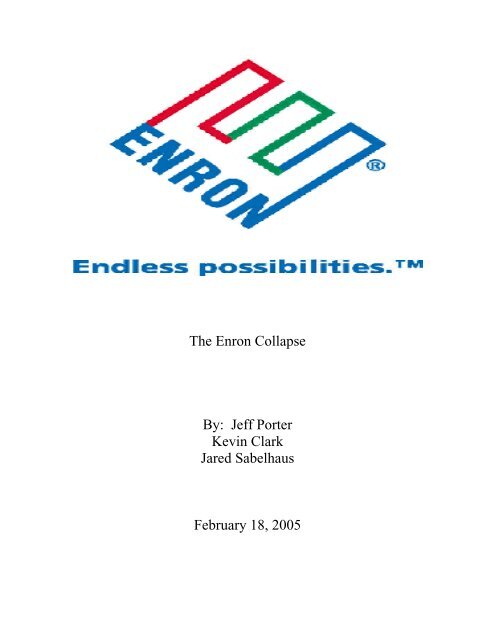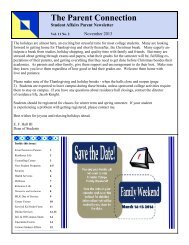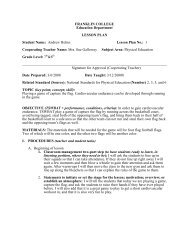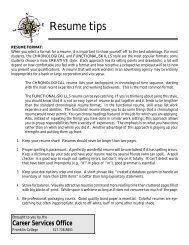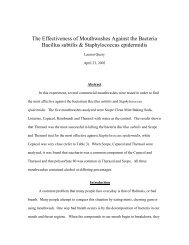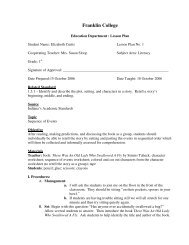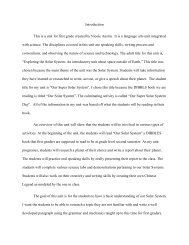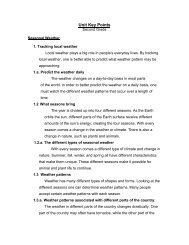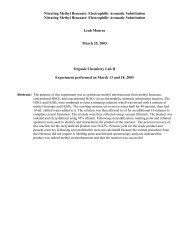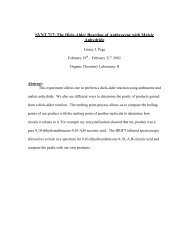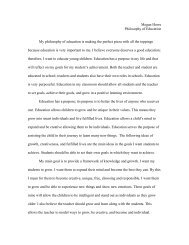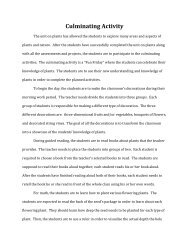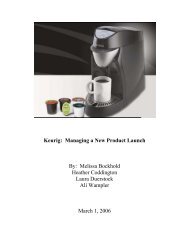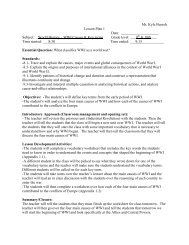The Enron Collapse By: Jeff Porter Kevin Clark ... - Franklin College
The Enron Collapse By: Jeff Porter Kevin Clark ... - Franklin College
The Enron Collapse By: Jeff Porter Kevin Clark ... - Franklin College
You also want an ePaper? Increase the reach of your titles
YUMPU automatically turns print PDFs into web optimized ePapers that Google loves.
<strong>The</strong> <strong>Enron</strong> <strong>Collapse</strong><br />
<strong>By</strong>: <strong>Jeff</strong> <strong>Porter</strong><br />
<strong>Kevin</strong> <strong>Clark</strong><br />
Jared Sabelhaus<br />
February 18, 2005
Introduction<br />
Companies have mission statements that often read like inspirational leaflets.<br />
<strong>Enron</strong>’s mission was at first to be the world’s greatest energy company then later revised<br />
in early 2001 to be the “world’s greatest company”. In the late 1990’s, <strong>Enron</strong> seemed to<br />
have accomplished their mission accumulating vast amounts of assets, had the<br />
intellectually elite at the helm, a political climate in their favor and numerous<br />
opportunities to expand. <strong>Enron</strong> gave all appearances of a vastly superior company that<br />
could do no wrong. <strong>The</strong> thing about king of the mountain is that the ones on top never<br />
seem to stay there for very long and in <strong>Enron</strong>’s case the fall from corporate mountain was<br />
spectacular and felt all over the world. Over the course of three short years <strong>Enron</strong> went<br />
from the seventh largest company in the U.S. to financial ruin. However deep and<br />
impressive their intelligent managerial pool was; internal flaws led to a slide of epic<br />
standards. In our report, we will analyze these internal flaws that include inadequate<br />
control measures, a hostile environment and flawed accounting and financing methods.<br />
Because of the financial severity which the company was in we concluded that Filing<br />
Chapter 11 bankruptcy was the only option for <strong>Enron</strong> and therefore will be assumed in<br />
our report. When we asked Rich Kidwell if there was anything <strong>Enron</strong> could have done to<br />
keep from filing Chapter 11 he said “I don’t know if there was anything that they could<br />
do. <strong>Enron</strong> was like a house of cards and it was only a matter of time before they were<br />
blown down.” We examined different ideas on how to transform these flaws and then<br />
suggest which idea we feel is best suited to the needs of this company.
Assumptions<br />
While writing this paper we assumed the following points:<br />
• <strong>Enron</strong> has already filed for Chapter 11 bankruptcy.<br />
• <strong>Enron</strong> is unique in regards to size and operations (accounting methods and<br />
actions) compared to other regulated commodity companies.<br />
• Due to <strong>Enron</strong>’s aggressive accounting we understand the financial ratios that are<br />
Brief History<br />
computed using <strong>Enron</strong>’s financial statements are more than likely not going to<br />
give an accurate or clear picture of the company’s current status.<br />
• 1985- <strong>Enron</strong> is formed by merger of Houston Natural Gas and InterNorth<br />
creating the largest company owned natural gas pipeline.<br />
• 1989- <strong>Enron</strong> opens its Gas Bank, where consumers can buy long-term<br />
supplies of natural gas at a fixed price, setting the stage to become a<br />
commodity trading company.<br />
• 1990-1998- <strong>Enron</strong> expands its holdings in the U.K., Europe, South<br />
America, and India. <strong>Enron</strong> in this time moved away from natural gas and<br />
pipeline operations instead focusing more on marketing other energy-<br />
related commodities.<br />
• 1999- <strong>Enron</strong> launches its broadband services and <strong>Enron</strong> Online.<br />
• August 2000- <strong>Enron</strong>’s share price reaches an all time high of $90, ranking<br />
it the seventh largest energy company in the world.
S.W.O.T. Analysis<br />
Strengths<br />
• October 2001- <strong>Enron</strong> post its first quarterly loss in four years, $618<br />
million and a reduction in shareholder equity by over $1 billion dollars.<br />
• December 2, 2001- <strong>Enron</strong> files for bankruptcy protection.<br />
<strong>Enron</strong> is the largest company-owned natural gas pipeline system in the United<br />
States and is ranked seventh on the Fortune 500 giving it an established name with<br />
credibility. Another strength of the company would be its reputation and public<br />
perception. <strong>Enron</strong> has a competitive and almost monopolistic advantage over its<br />
competitors because they are the largest energy provider. <strong>The</strong>y also have market-making<br />
abilities that result in price and service advantages (26).<br />
Weaknesses<br />
It is easy to target <strong>Enron</strong>’s weaknesses in the company. <strong>The</strong>y have a lack of<br />
ethical and moral behavior among employees and auditors by engaging in deceitful and<br />
wrongful acts. Management has a lack of control and conflicts of interest occur in<br />
numerous transactions. <strong>The</strong> culture of <strong>Enron</strong> was all about results therefore, expectations<br />
of financial statements were high and employees were told to make up for losses.<br />
Opportunities<br />
Name recognition is an opportunity for <strong>Enron</strong>. Society recognizes <strong>Enron</strong> as a high<br />
quality energy provider. <strong>The</strong>re are many opportunities for <strong>Enron</strong> to expand or use to their<br />
advantage the many assets they have such as pipeline. Deregulation of the energy<br />
industry in the 1970s allowed <strong>Enron</strong> the opportunity to grow and begin trading.
Threats<br />
<strong>The</strong>re are many threats <strong>Enron</strong> faces. Competitors could come in and steal some<br />
partners <strong>Enron</strong> does business with potentially taking away profits from <strong>Enron</strong>. Threats<br />
exist that newer technology will provide alternative energy sources to oil and gas,<br />
<strong>Enron</strong>’s two major sources of energy. A possible threat would also be if the energy<br />
market became regulated again and trading could not occur.<br />
Internal Flaws<br />
Accounting<br />
Another problem <strong>Enron</strong> faced was the aggressive accounting style used to inflate many<br />
figures on their financial statements. Many complicated partnerships with special purpose<br />
entities and other subsidiaries made the accounting even more confusing. <strong>The</strong>se methods<br />
helped <strong>Enron</strong> manipulate their revenue and earnings.<br />
“Mark to Market” Accounting<br />
<strong>Enron</strong> used “mark to market” accounting, which allowed them to adjust the value of a<br />
security or asset to reflect the current market value (20). This procedure allows<br />
companies to book as current earnings their expected future revenue from certain assets<br />
(7). <strong>The</strong> introduction of volumetric production payments opened the door for this type of<br />
accounting. <strong>The</strong>se payments were contracts that had a predictable future cash flow and<br />
could be treated as merchant assets meaning the assets held on <strong>Enron</strong>’s books could be<br />
traded at any time if they received a suitable offer (20). <strong>The</strong> SEC granted <strong>Enron</strong><br />
permission to mark these assets to market in 1991 and was supposed to be on a temporary
asis, but the SEC has not introduced this topic since. To create a merchant asset deal, the<br />
trader would forecast the future price curve for the underlying product, calculate the<br />
future cash flows and apply a discount rate to compute the net present value which could<br />
either be sold to a special purpose entity (SPE) created for that purpose or kept on<br />
<strong>Enron</strong>’s books as a merchant asset (20). Market prices for gas futures could be obtained<br />
from the New York Mercantile Exchange (NYMEX) but for a limited time range, usually<br />
four years. <strong>Enron</strong> extended this principle to longer contracts, for which it had to derive its<br />
own price curves (20). For example, a 20-year deal where the energy company’s<br />
generation unit builds and sells the output of a multi-million dollar power plant. <strong>The</strong>re is<br />
no NYMEX for power prices going out 20 years so an estimate must be made.<br />
Accounting standards allow management to use its discretion to determine future income<br />
and cost. If it is determined that the company must sell the power for 4.8 c/KWH (cents<br />
per kilowatt hour) while realizing an estimated cost of 4.5 c/KWH, all these less than<br />
certain future profits are recognized in the present earnings. If in future quarters, when<br />
the real numbers come in and profits do not meet expectations, the energy company can<br />
offset the losses by entering into additional deals. <strong>The</strong> best way to cover up a bad deal is<br />
to make two more (15). <strong>Enron</strong> used “mark to market” accounting involving two specific<br />
companies, Blockbuster and Quaker. In 2000, <strong>Enron</strong> entered into an agreement with<br />
Blockbuster to deliver movies on demand to viewers’ homes over <strong>Enron</strong>’s broadband<br />
network. This venture fell apart within months, but <strong>Enron</strong> still booked $110 million in<br />
profits in late 2000 and early 2001, based on the anticipated value of the partnership over<br />
20 years (7). “Mark to market” gains accounted for over half of <strong>Enron</strong>’s reported pretax<br />
earnings in 2000. Another deal created to use “mark to market” accounting involved
Quaker Oats in 2001. <strong>Enron</strong> agreed to supply 15 Quaker plants with their energy needs,<br />
from natural gas and electricity to workers who would maintain boilers and pipes. <strong>Enron</strong><br />
guaranteed it could save Quaker $4.4 million from its energy bill (16). <strong>Enron</strong> then<br />
forecast a $36.8 million profit over the 10-year deal and under “mark to market”<br />
accounting booked $23.4 million of that before they had ever turned on Quaker’s lights<br />
(16). <strong>The</strong> rules permit this to occur for commodities like natural gas and electricity, but<br />
when it comes to services, the rules are more restrictive. Profits from service activities are<br />
to be booked on an accrual basis, in which a fraction of the profit is realized each year.<br />
<strong>The</strong> Quaker deal projected profits from services, not commodities causing a major<br />
problem. <strong>Enron</strong> used a method called revenue allocation designed to redefine as<br />
commodities some of the money Quaker was paying for services and therefore create<br />
more profits for <strong>Enron</strong> to book up front (16). Internal accountants created a new category<br />
called allocated revenues which was based on figures <strong>Enron</strong> claimed reflected the open<br />
market value of the commodities and services, not what Quaker had historically paid for<br />
energy commodities (16). “Mark to market” accounting is very aggressive and<br />
overlooked by the SEC, especially in <strong>Enron</strong>’s case.<br />
Sham Swaps<br />
<strong>Enron</strong> and telecommunications giant Qwest Communications struck a deal in 2001 to<br />
swap fiber-optic network capacity and services. Qwest agreed to pay <strong>Enron</strong> $308 million<br />
for assets that included dark fiber, strands that require additional investment before they<br />
can be put into service, along a route from Salt Lake City to New Orleans. <strong>Enron</strong> agreed<br />
to pay Qwest $195.5 million for active fiber-optic cable services over a 25-year period.
This enabled <strong>Enron</strong> to avoid recording a loss on dark fiber assets, whose value in the<br />
open market dropped below the price on <strong>Enron</strong>’s books, by booking a sale (17, 7).<br />
Prudence Accounts<br />
<strong>Enron</strong> used prudence accounts to make their revenue stream appear less volatile than it<br />
actually was. <strong>Enron</strong> traders split profits from deals into two categories. <strong>The</strong> first would<br />
allow profits to be added directly to the company’s financial statements, and the other<br />
category would allow profits to be added to a reserve fund. According to Frank Partnoy,<br />
an expert in finance who testified before the U.S. Senate Committee on Governmental<br />
Affairs, the prudence accounts served as a slush fund that could be used to smooth out<br />
profits and losses over time (7). An example would be a trader who earned a profit of $10<br />
million. Of that $10 million, the trader might record $9 million as profit today, and enter<br />
$1 million into a prudence account (18). In other words, traders were saving for a rainy<br />
day. <strong>Enron</strong> was misstating the volatility and current valuation of its trading businesses,<br />
and misleading its investors.<br />
Off Balance Sheet Transactions<br />
Chewco<br />
Chewco was the first deal with an <strong>Enron</strong> employee and a special purpose entity to cause<br />
controversy. <strong>The</strong> SPE could be treated as if it were an independent, outside entity for<br />
accounting purposes if two conditions were met: an owner independent of the company<br />
must make a substantive equity investment of at least 3% of the SPEs assets, and that 3%<br />
must remain at risk, that is, not guaranteed by someone else, throughout the transaction;
and the independent owner must exercise control of the SPE. If those conditions are met,<br />
the company can record gains and losses on transactions with the SPE, and the assets and<br />
liabilities of the SPE are not included in the company’s balance sheet (21). <strong>Enron</strong> used<br />
SPEs to shift liabilities, its debt, off its books. Michael Kopper became the independent<br />
investor in Chewco. He and a friend invested $125,000 of their own money, with <strong>Enron</strong><br />
providing collateral and received an $11 million loan from Barclays Bank. <strong>Enron</strong><br />
recorded its contractual share of gains and losses from the Joint Energy Development<br />
Investment (JEDI) on its income statement and disclosed the gain or loss separately in its<br />
financial statement footnotes, but did not show JEDI’s debt on its balance sheet (21). <strong>The</strong><br />
purpose of Chewco was to acquire the California Public Employees Retirement Scheme’s<br />
(CalPERS) interest in an earlier joint venture with <strong>Enron</strong> called JEDI so CalPERS would<br />
invest in another, larger partnership (7). <strong>The</strong> only way <strong>Enron</strong> could avoid consolidating<br />
JEDI onto their financial statements were if Chewco had an independent owner with a<br />
minimum of 3% of equity capital at risk. <strong>The</strong>y could not find any outside investor so they<br />
financed Chewco’s purchase of the JEDI interest almost entirely with debt, and <strong>Enron</strong> did<br />
not consolidate Chewco into its consolidated financial statements disregarding<br />
accounting requirements for non-consolidation (21). Under <strong>Enron</strong>’s Cod of Conduct of<br />
Business Affairs, Kopper was prohibited from having a financial or managerial role in<br />
Chewco unless the Chairman or CEO determined that his participation did not adversely<br />
affect the best interest of the company, which we have no evidence of (21).
LJM Partnerships<br />
In June of 1999, LJM 1, a Cayman Islands SPE, was formed. Fastow served as the<br />
general partner and invested $1 million of his own money. He raised $15 million from<br />
two limited partners, through an SPE, to get debt off the balance sheet by having <strong>Enron</strong><br />
purchase certain assets and associated liabilities the company wanted removed from its<br />
balance sheet (20). <strong>The</strong> conflicts of interest prohibited <strong>Enron</strong> from having any dealings<br />
with officers of the company according to their code of ethics. But, the board of directors<br />
gave special permission to Fastow subject to certain checks put in place to protect<br />
<strong>Enron</strong>’s assets. LJM 1 entered into numerous transactions with <strong>Enron</strong>. One example,<br />
LJM 1 hedged <strong>Enron</strong>’s position with Rhythms NetConnections stock, which <strong>Enron</strong><br />
bought for $1.85 per share and rose to $69 at the end of the trading day (20). <strong>The</strong><br />
investment in Rhythms was worth about $300 million in May of 1999 so <strong>Enron</strong> wanted to<br />
protect itself against future income volatility (21). <strong>By</strong> hedging, <strong>Enron</strong> could offset losses<br />
on Rhythms if the price of Rhythms declined. LJM Swap Sub Limited Liability<br />
Partnership, controlled by Fastow, issued a put option on the Rhythms shares in exchange<br />
for a supply of restricted <strong>Enron</strong> stock and various notes. This option would entitle <strong>Enron</strong><br />
to recover any loss in the value of the Rhythms shares. LJM Swap Sub would pay for<br />
such losses out of the value of the restricted <strong>Enron</strong> stock it received. Any “mark to<br />
market” losses would be shifted from <strong>Enron</strong> to LJM Swap Sub (22). LJM 2 was formed<br />
in October of 1999. Fastow raised $200 million of institutional private equity to purchase<br />
assets that <strong>Enron</strong> wanted to syndicate. LJM 2 solicited prospective investors as limited<br />
partners using a confidential Private Placement Memorandum (PPM) detailing the<br />
"unusually attractive investment opportunity" resulting from the partnership's connection
to <strong>Enron</strong> (21). At the end of 1999, <strong>Enron</strong> sold interests in seven assets to LJM<br />
partnerships. <strong>The</strong> LJM partnerships were shady because <strong>Enron</strong> bought back five of the<br />
seven assets after the close of the financial reporting period allowing them to report the<br />
gain on their financial statements. <strong>The</strong> LJM partnerships made a profit on every<br />
transaction, even when the value of the asset declined and the transactions generated<br />
earnings of $229 million in the second half of 1999 for <strong>Enron</strong> (20).<br />
Raptor Partnerships<br />
Four new SPEs were established in 1999 and 2000 known as the Raptor Partnerships.<br />
<strong>The</strong>se deals were extremely complicated with <strong>Enron</strong> funding it with its own stock to<br />
hedge against declines in the value of <strong>Enron</strong>’s merchant investments (21). LJM 2<br />
provided the outside equity to avoid consolidation of the Raptor SPEs. Talon was the<br />
SPE set up for the Raptor partnerships to absorb <strong>Enron</strong>’s “mark to market” losses.<br />
Harrier, an <strong>Enron</strong> subsidiary, invested $1,000 equity in Talon for “special interest limited<br />
partnership equity,” entitling <strong>Enron</strong>/Harrier to execute equity swap transactions with<br />
Talon, and, under certain circumstances, to all of Talon’s profits exceeding $41 million.<br />
LJM 2 contributed $30 million of equity to Talon, with the understanding that it would<br />
receive a return of $41 million on this investment before <strong>Enron</strong>/Harrier could proceed to<br />
trade derivatives with Talon. To fund future hedge transactions, <strong>Enron</strong>/Harrier issued<br />
Talon approximately 3.7 million restricted shares of <strong>Enron</strong> stock, and rights to an<br />
additional 3.9 million shares to be issued under certain circumstances in future years. All<br />
of these shares had a current face value of approximately $537 million. In exchange for<br />
these shares and options, <strong>Enron</strong> received net notes from Talon worth $350 million. (22)
Two of the Raptor SPEs lacked credit capacity to pay <strong>Enron</strong> on the hedges. So <strong>Enron</strong> was<br />
supposed to take a pre-tax charge against earnings of more than $500 million, but <strong>Enron</strong><br />
restructured the Raptor deals by having more than $800 million of contracts transferred to<br />
receive its own stock before the quarter ended (21). <strong>The</strong> result of the Raptor deals was a<br />
$544 million after-tax charge against earnings in 2001, which forced <strong>Enron</strong> to reduce<br />
shareholders’ equity by $1.2 billion.<br />
Financial Summary<br />
To evaluate <strong>Enron</strong> fully, we need to look at their financial statements and ratios.<br />
<strong>The</strong> results are from the year 2000 and we feel an assumption must be made about the<br />
validity of these numbers. We used the financial statements provided by <strong>Enron</strong> for 2000,<br />
but feel the numbers don’t fully represent the truth and analyzing them any further would<br />
not provide us with a more accurate picture of the company. Profit margin tells us for<br />
every dollar in sales it generates .0097 cents in profit, .97% (20). Another measure of<br />
profitability is the return on equity, Return on equity is a measure of how the<br />
stockholders did during the year (14). For every dollar in equity, <strong>Enron</strong> generated around<br />
8.5 cents in profit, or 8.54% (20). Return on assets is a measure of the profit per dollar of<br />
assets (14). For every dollar of total assets, <strong>Enron</strong> generated about 1.5 cents in profit, or<br />
1.49% (20). <strong>Enron</strong> has so many assets that this number is going to be small. Some<br />
liquidity ratios are the current ratio, quick ratio, and net working capital. <strong>The</strong> current ratio<br />
is a measure of a company’s short-term liquidity (14). For every dollar in current<br />
liabilities, <strong>Enron</strong> is covered 1.07 times over (20). <strong>The</strong> quick ratio is computed the same as<br />
the current ratio except it omits inventory. <strong>Enron</strong>’s quick ratio was 1.036 times. Net
working capital is the ability to meet short-term obligations (14). <strong>The</strong> net working capital<br />
for <strong>Enron</strong> is $1.975 billion with the net working capital ratio equal to around 3% (20).<br />
<strong>The</strong> debt to equity ratio is a measure of a company’s financial leverage and the<br />
proportion of debt and equity it is using to finance its assets (23). <strong>Enron</strong> has a debt to<br />
equity ratio of .692 times, which is quite high (24). <strong>Enron</strong> is very asset heavy. Total<br />
assets increased from $33,381,000 billion in 1999 to $65,503,000 billion in 2000, an<br />
increase of over 96%.<br />
<strong>The</strong> net income of <strong>Enron</strong> is a figure that needs some discussion. Although it has<br />
increased from $703 million in 1998 to $893 million in 1999 to $979 million in 2000,<br />
there are some discrepancies about its validity (20). <strong>The</strong> Chewco and LJM Partnerships<br />
reported income, which should not have been booked. According to the Powers Report,<br />
this would have reduced reported net income by $133 million in 1998, $248 million in<br />
1999, and $99 million in 2000 (21). <strong>Enron</strong>’s net income cannot be credible until changes<br />
are made to correct their “mark to market” accounting. <strong>The</strong> cash flow from investing<br />
activities is a negative $4.264 billion. <strong>The</strong> biggest component of this is the acquisition of<br />
subsidiary stock decreasing cash flow from investing by $485 million and a decrease of<br />
$777 million from business acquisition (20). <strong>The</strong> financial situation of <strong>Enron</strong> by the<br />
books is stable, but the use of “mark to market” accounting and off the balance sheet<br />
transactions will distort the numbers and potentially provide insecurity to <strong>Enron</strong>.<br />
Financial Ratios <strong>Enron</strong><br />
Profit Margin .97%<br />
Return on Equity 8.54%<br />
Return on Assets 1.49%
Current Ratio 1.07<br />
Quick Ratio 1.036<br />
Net Working Capital $1.975 billion<br />
Debt to Equity 69.2%<br />
Total Debt $10.229 billion<br />
Total Equity $14.788 billion<br />
International Institute of Management Development<br />
(http://www.senate.gov/~gov_affairs/072302roach_a.pdf#search='enron%20total%20debt')<br />
Total Equity is equal to Shareholders’ Equity, Company-Obligated Preferred Securities of Subsidiaries and Minority<br />
Interests.<br />
Millions of dollars<br />
$70,000<br />
$60,000<br />
$50,000<br />
$40,000<br />
$30,000<br />
$20,000<br />
$10,000<br />
Control Issues:<br />
$0<br />
Conflict of interest<br />
1999 2000<br />
Total Assets<br />
Current<br />
Assets<br />
Total Debt<br />
Long Term<br />
Debt<br />
Total Equity<br />
Shareholders'<br />
Equity<br />
A company the size of <strong>Enron</strong> must maintain such a strict direction in which the<br />
company otherwise, it is so easy to get off the beaten path when you’re a company of that<br />
magnitude. Having complete control of what the company is and does is essential to its
survival. “For any corporation to be healthy and productive, it needs to be strong<br />
in…social-spiritual capital in terms of ethics, relationships, meaning and purpose (13).”<br />
<strong>The</strong> culture of the company must all have the same goal and all be working towards that<br />
goal. One of the problems with <strong>Enron</strong> was all of its conflicts of interest in its<br />
infrastructure, its financial transactions and its accounting practices.<br />
Mark & Skilling<br />
From the moment Kenneth Lay hired <strong>Jeff</strong> Skilling in 1989 there was a struggle in<br />
upper management between he and colleague rival Rebecca Mark. Both wanted sole<br />
control of the strategic direction which the company was to head and both directions were<br />
extremely different. Skilling wanted <strong>Enron</strong> to go from being a generator and supplier of<br />
different energy commodities to becoming a middleman by focusing directly on trading<br />
in energy (7). He believed in an “asset light” company. Mark was more traditional and<br />
had a reputation for pushing hard to seal deals (4). She wanted to focus on power<br />
generating assets at home and abroad (7). As a result of this, the company would<br />
continue to pursue different investing strategies until Skilling’s appointment as chief<br />
operating officer in 1996.<br />
Andersen<br />
Arthur Andersen was an eighty-nine year old firm built on the reputation of strong<br />
ethics, accounting and auditing guidelines. <strong>The</strong>y were among what the industry calls “the<br />
big five” accounting firms in the world. <strong>The</strong>y were respected, law abiding, and above all<br />
ethical. But when a firm like <strong>Enron</strong> comes along and pays you $51 million a year for
your accounting and consulting services an auditor wouldn’t dare “offend a big client<br />
with uncomfortable scrutiny (10).” After a while hands start washing each other and a<br />
new unwritten company policy is formed. Many thought the relationship was closer than<br />
usual. Andersen’s auditors were in-house. Some <strong>Enron</strong> employees were quoted as<br />
saying that “people just thought they were <strong>Enron</strong> employees (7).” Andersen’s own<br />
infrastructure had conflicting views about the way difficult accounting issues should be<br />
handled. Andersen had a professional standards group (PSG) at its corporate<br />
headquarters whose job was to review these difficult issues shall they occur (7). PSG’s<br />
are set at most big accounting firms, but unlike all the other firms Andersen’s PSG did<br />
not have the authority to overrule its field auditors if one of these difficult issues were to<br />
arise. On several occasions the <strong>Enron</strong> audit team proceeded with their accounting<br />
procedures despite the objections of the PSG (7).<br />
Fastow Deals<br />
Andrew Fastow, <strong>Enron</strong>’s chief financial officer, formed many small offshoots of<br />
<strong>Enron</strong> called Special Purpose Entities (SPEs). <strong>The</strong> only purpose proved to be building<br />
his and other top executives wealth while mounting debt. Fastow originally started LJM<br />
and formed many subsidiaries from this original SPE. <strong>By</strong> having Fastow play this dual<br />
role <strong>Enron</strong> was violating one of its codes of ethics, which prohibited an officer from<br />
owning or participating in “any other entity which does business with…the company<br />
(6).” <strong>The</strong> only exception is if the participation was disclosed to the chairman and CEO<br />
and was judged not to “adversely affect the best interests of the company (6).” As a
esult, the board reviewed and approved the LJM partnerships and voted to suspend its<br />
code of ethics in this instance to permit Fastow to run the partnerships.<br />
Ethics:<br />
Disclosure of Info<br />
Officials to employees and public<br />
All markets are considered efficient. Stock prices are a reflection of all available<br />
information to the public about any certain company and the price is a good indication of<br />
whether or not a company is doing bad or good or going to do worse. <strong>The</strong>re is no<br />
predicting the market because it is perfectly efficient. That is why the fall of <strong>Enron</strong> had<br />
such an impact on the business world, no one saw it coming. <strong>The</strong> financial statements<br />
were looking good and the mainstay of the company Kenneth Lay was still stating that<br />
the company is the strongest it has ever been just weeks before its demise. Stock prices<br />
stayed steady because the market had no information to report otherwise. Insiders were<br />
still ranking <strong>Enron</strong>’s stock as a “hold” the day they filed Chapter 11. <strong>The</strong> whole time Lay<br />
talked up the company’s financial stance he and other top officials were dumping<br />
millions of dollars worth of <strong>Enron</strong>’s stock. No one knew and no one could react until it<br />
was too late.<br />
Ethical Summary<br />
In the weeks leading up to <strong>Enron</strong>’s demise CEO Kenneth Lay was still selling<br />
<strong>Enron</strong> as being in perfect financial health. He told employees that the company was<br />
financially stronger than it’s ever been, while he turned around and dumped the majority<br />
of his stock. <strong>The</strong> company eventually lost millions, employees lost their retirement and<br />
shareholders lost their investment. <strong>Enron</strong> kept accounting documents hidden and well
manipulated and while the auditing team at Andersen stood by and said nothing for fear<br />
they would lose the account. <strong>The</strong>se kinds of issues question the ethics in which <strong>Enron</strong><br />
and Arthur Andersen did business. When I asked Rich Kidwell, financial advisor for<br />
Merrill Lynch and former CPA, if he could pinpoint one thing that directly led to the<br />
downfall of <strong>Enron</strong> he said “fraud.” And when I asked Ken Flora, Team Leader of<br />
Accounting Operations at Indianapolis Power and Light, the same question, I got almost<br />
the same answer, “unethical accounting and operations.” Joe McGee, CLU and ChFC at<br />
AUL Tower Agency, he gave a similar response. Three industry experts all agreed that<br />
the leading cause of <strong>Enron</strong>’s collapse was the breakdown in moral and ethical business<br />
practices.<br />
Culture<br />
A company’s culture is what determines in large degree how their employees act.<br />
Organizational culture spurs from customs, traditions, and the general way things are<br />
done that have evolved over time (12). As <strong>Enron</strong> transformed from an old regulated gas<br />
company to a fast deal making powerhouse, the culture it developed was a major reason<br />
of for its downfall. Touted throughout the nineties as the triumph of the new economy,<br />
they believed that their culture was fast, adaptive and innovative (2). To get the whole<br />
picture of what working at <strong>Enron</strong> is like an examination must begin with new employees.<br />
<strong>Enron</strong>’s size and new innovative business plan attracted the top MBA talent from the best<br />
business schools in the country, mostly new graduates. <strong>Enron</strong> emphasized risk-taking<br />
and entrepreneurial thinking (2). As a result, <strong>Enron</strong>’s managers tended to be over<br />
confident and cocky, as is the tendency of most young people. <strong>Enron</strong> had a typical
turnover for a large company and it placed great stress on having a young, intelligent,<br />
high energy work force. For instance top management positions were filled by people<br />
younger than 50; CEO <strong>Jeff</strong> Skilling was 46, CFO Andrew Fastow was 38 and top trader<br />
John Arnold was 26.<br />
Youth and arrogance lead <strong>Enron</strong> to push its employees to maximize revenue at<br />
all costs. Executives were at the forefront, encouraging new ideas and initiatives that<br />
might have looked good on paper but were drains when put into action. <strong>The</strong>ir slogan in<br />
the late 90’s became “We make Markets” expanding into broadband, paper, electricity,<br />
weather, along with others all in the name of revenues. <strong>The</strong> problem with these ideas and<br />
initiatives was that no one seemed to care if they were drains or not. <strong>The</strong>y cared more<br />
about making their “quota” to make the books look good. Bosses at <strong>Enron</strong> frequently<br />
made “tweaks” to the numbers to squeeze out more of deals in efforts to make deals look<br />
good. <strong>Enron</strong> was not only spending money expanding into new markets it also spent a<br />
great deal trying to expand their influence into politics. <strong>Enron</strong> routinely requested and<br />
was granted less government regulations (7). <strong>The</strong>y spent millions lobbying government<br />
officials and members of the SEC to get less government oversight. <strong>The</strong>ir success in<br />
getting several exemptions gave them a free range in several areas that they took<br />
advantage. For instance, the last thorough examination of <strong>Enron</strong>’s annual reports was in<br />
1997 (7).<br />
With the insistence on growth, managers were constantly being rated on<br />
performance. Every six months or so analysts in training would be ranked and the<br />
bottom ten percent would be given their walking papers. <strong>The</strong>se ranking were based on<br />
different criteria but certain areas got more attention than others. More stress was put on
creativity than integrity. For instance, “intellectual curiosity” was one criterion that<br />
counted as much as anything in the performance evaluation. This consisted of how many<br />
ideas the person came up with and started up a new business or process, even if there<br />
wasn’t a demand for the business (3). For example, Lynda Clemmons in 1997 launched<br />
weather derivatives. Her start up, within two years, had written $1 billion in weather<br />
hedges to protect against short-run spikes in power prices (3). <strong>Enron</strong> declared this as<br />
another high-potential market for the company but the idea never panned out and was<br />
scraped shortly after. Whether an idea was successful or not did not seem to matter, only<br />
if employees kept coming up with new ideas to make sure that they survived the routine<br />
purges. <strong>The</strong> pressure to come up with deals was enormous and lead to what became<br />
called as “Friday night specials”. <strong>The</strong>se deals were hastily put together and often with no<br />
apparent planning on how to manage the deals. <strong>The</strong>se “specials” were often done with<br />
aggressive accounting that took ethical shortcuts, for illustration would be when they<br />
would book huge amounts of revenue before the contracts were signed and they would<br />
keep the revenue even if the deal fell through. Though most of these cases did knowingly<br />
cross that ethical line, some might have just been because of young executives. In pursuit<br />
of never-ending growth <strong>Enron</strong> expanded into unfamiliar areas and with executives<br />
churning into new positions, sometimes as much as once a year, there is a possibility that<br />
inexperience played a role in some mistakes. We would however not suggest that<br />
<strong>Enron</strong>’s unethical behavior was caused by inexperience due to the wealth of information<br />
coming out on the corruption.<br />
<strong>The</strong> pressure to perform had its consequences but it also had its rewards. During<br />
the period from 1998 to 2000 total compensation for the top 200 employees went up
more than 630% from $193 million to $1.4 billion. <strong>The</strong> majority of the gains were given<br />
in stock options. <strong>The</strong>se executives started to care only about keeping the stock price as<br />
high as possible. Along with the compensation packages <strong>Enron</strong> routinely lent money to<br />
top executives, which were forgiven if the terms of their contracts were fulfilled (7).<br />
To complete the performance review a group of twenty people were selected to<br />
rank more than 400 vice presidents, then all of the directors, then all <strong>Enron</strong> managers<br />
(2). <strong>The</strong> reward for being a manager rated superior (top 5%) were bonuses of 66%<br />
higher than those in the excellent group. This ranking policy had the effect of making<br />
people incredibly careful not to offend any of the reviewers, thereby creating a culture of<br />
“yes-men” (3). Skilling was very hands on when it came to ranking employees for<br />
compensation. <strong>The</strong>re were several people who cited that Skilling on several different<br />
occasions held up a persons performance review because he was trying to get back at
them for criticizing or what they called stepping out of line (2). This led to a development<br />
in the number of “yes men” that were afraid if they criticized or expressed disagreement<br />
that their careers would be severely damaged when it came time for performance review.<br />
<strong>The</strong> <strong>Enron</strong> environment bread a risk-taking culture that only cared about growth<br />
at any cost. <strong>The</strong>re was no manager to set the example on what to do or not to do.<br />
Criticism and dissention were met with hostility and there was no counter balance to new<br />
ideas that were presented. <strong>The</strong> emphasis on earnings lead employees to take ethical short<br />
cuts to keep up since creativity was reward more than integrity (3). A definite agency<br />
problem came to light between the managers and shareholders. With the compensation<br />
packages and performance reviews, employees cared more about their own welfare and<br />
not the welfare of the company.<br />
Suggestions<br />
<strong>Enron</strong> had a code of ethics in place but did not comply or enforce its own rules.<br />
We feel that along with changes to accounting methods there also needs to be drastic<br />
changes in the culture and operational control management.<br />
Alternatives to current culture that <strong>Enron</strong> could adopt<br />
• Progressive-adaptive- A culture which stresses openness to new ideas, adapts<br />
quickly to shifting market conditions. Company is future-oriented and wants to<br />
catch waves of change (13).
• Purpose-driven- Leadership effectively directs the company on a clear course. A<br />
common purpose is defined that is shared by all employees who are committed to<br />
the same set of core values (13).<br />
• Community-oriented- A strong emphasis is placed on collectivity and cooperation.<br />
Leadership builds a company in which people respect, support each other.<br />
Employees express their ideas rather than try to just “fit in”. (13).<br />
• People centered- A genuine caring for each worker by the company. Individual<br />
employees are encouraged to develop their full potential, personally and<br />
professionally (13).<br />
Strengths and weaknesses of cultural system<br />
Progressive-adaptive<br />
culture<br />
Strengths Weaknesses<br />
• Open to new ideas<br />
• Reacts quickly<br />
• Future oriented<br />
Purpose-driven • Clear Company direction<br />
• Commitment to core<br />
values<br />
• Cares about more than<br />
bottom line<br />
Community-oriented • Team oriented<br />
• Empowers employees<br />
• Openness to ideas<br />
People-oriented • Freedom to grow<br />
• People oriented<br />
• Risk taking<br />
• Outcome Oriented<br />
• Risk averse<br />
• Outcome Oriented<br />
• Less independence<br />
• Possible conflicts of<br />
interest
Type of control systems<br />
• Market- Uses external mechanisms like market share, price competition. Under<br />
this system a company’s divisions are evaluated by how much profits they<br />
achieve for the company as a whole (12).<br />
• Clan- Workers are regulated by shared values, traditions, rituals, and norms.<br />
Behavior depends on identifying with a certain group and behaving in a way that<br />
reflects on the group or team (12).<br />
• Bureaucratic- Emphasizes an organizational authority. That authority has set up<br />
an extensive set of rules, regulations, polices, and procedures (12).<br />
Strengths and weaknesses of Control Systems<br />
Market Control • Easy to monitor<br />
• Flexible<br />
Clan Control • Shared values<br />
• Flexible<br />
Bureaucratic control • Formal<br />
• Extensive<br />
Alternatives to Accounting and Finance<br />
Strengths Weaknesses<br />
• Profit driven<br />
• Results oriented<br />
• Informal<br />
• Variations possible<br />
• Slow<br />
• Inflexible<br />
• Transparency committee- Investors want adequate information to reliably assess<br />
how a company is being run and what its risks are. An audit committee is only<br />
there to assure that the firm is following GAAP as certified by the outside<br />
auditors. A “transparency committee” would spend its time evaluating the<br />
efficiency of the policies and decisions that have a greater impact on investors’
perceptions of the company. <strong>The</strong> goal should be to help investors and other<br />
members of the board of directors understand the firm’s value proposition,<br />
strategy, key success factors and risks (25).<br />
• Auditing Business Model Reform- Auditors are to help investors identify stocks<br />
that are good investments and those that are not. Auditors need to change their<br />
strategy from minimizing the costs and legal risks of performing this task and<br />
trying to increase profits in other areas like consulting, while instead focusing on<br />
maximizing the value of audits. Auditor independence can be achieved when<br />
auditors see audit committees as their real clients, not top management. Incentives<br />
inside the audit firms need to encourage audit professionals to exercise judgment,<br />
and walk away from clients that don’t deserve their certification, even when they<br />
are big and important (25).<br />
• Accrual Accounting- Companies need to use accrual accounting to provide a more<br />
accurate description of a company’s value.<br />
• SEC Review- A semi-annual review by the SEC would almost guarantee a more<br />
accurate representation of a company’s statements. It could also prevent<br />
executives from participating in transactions with a conflict of interest.<br />
Strengths and weaknesses of Accounting and Finance<br />
Strengths Weaknesses<br />
Transparency Committee • Key business risks<br />
transparent to investors<br />
• Detail and attention to key<br />
issues of importance<br />
• Still violation of<br />
accounting rules<br />
• Reliance on external<br />
auditors advice
Auditing Reform • Maximize audit value • Compliance still an<br />
issue<br />
Accrual Accounting • Revenue and expenses • Requires highly<br />
recorded in period incurred skilled accountants<br />
• Stable and accurate<br />
statements<br />
SEC Review • Restore confidence to • Too much<br />
consumers and investors<br />
government control<br />
• More accurate financial<br />
statements<br />
Recommendations<br />
• Accounting and Finance. We need better disclosure to public, board members and<br />
employees. First, we want to go back to accrual accounting and stop the<br />
aggressive accounting immediately. We feel accrual accounting gives a clear and<br />
more accurate representation of earnings, financial statements and the overall<br />
welfare of the company. To regain consumer confidence we will submit<br />
ourselves to semi-annual review of our financial statements by the SEC. In our<br />
new financial statements we plan to put footnotes describing transactions terms<br />
and finance methods involved. This is in an effort to provide clarity on how we<br />
do business. Also, auditors will no longer be permitted an office space in <strong>Enron</strong>’s<br />
buildings. In addition, <strong>Enron</strong> will voluntarily rotate auditors every 5 years. An<br />
effort will be made also to control the quality of trades. To simplify and control<br />
small acquisitions and transactions we want to institute a payback period of 3<br />
years, in which cash flows must result in a positive net present value using accrual<br />
methods. For major project initiatives where a large initial investment will be<br />
involved, a decision making panel will consult to decide whether to proceed or
not. <strong>The</strong> hope of this decision making panel is to get a wide variety of opinions.<br />
Feedback will be collected through quarterly and annual internal audits of<br />
financial statements. We will submit to SEC audits at their request and we will<br />
hire an outside firm to do annual audits also of financial statements. Along the<br />
same lines several former finance policies will be stopped such as, executive<br />
loans and compensating top executives with huge chunks of stock options.<br />
• Control Systems. As far as control issues are concerned we feel that enforcement<br />
was extremely deficient. We suggest a change in the current control system to a<br />
bureaucratic system. This will formalize rules, procedures and polices especially<br />
in regards to integrity and ethics which will stop such behavior in employees.<br />
<strong>The</strong> major fault of this system is that it will slow our business down and decrease<br />
the number of transactions. We understand that this could hinder some of our<br />
deals but feel that a bureaucratic system will be strong and able to deal with the<br />
size of <strong>Enron</strong> especially when it comes to dealing with ethical issues. Included in<br />
this control system will be several checks and balances that were not in place<br />
before. First, during new hire orientation, employees will have to attend an ethics<br />
workshop. Also, employees will be required to attend one ethics seminar a year.<br />
In regards to advancement an effort will be made to keep people in their current<br />
jobs for at least 6 months in order to gain operational experience. As a way to<br />
insure quality trades the risk assessment and control division will be allowed more<br />
people and time to analyze trades and projects. In regards to reporting unethical<br />
activity, we propose an open door policy to report wrong doing. We also want to<br />
establish a position or committee to have the power to investigate and enforce
company’s guidelines on ethics and values made up of employees from every<br />
level of management where each has an equal vote. <strong>The</strong>se changes are rather<br />
large but we feel that they could take place immediately, within a few months.<br />
• Culture. <strong>Enron</strong>’s culture is one where there is no clear direction with a dual role<br />
of both an owner and trader of commodities. <strong>The</strong>y stress a highly competitive,<br />
arrogant, distrustful culture that made objecting to unethical behavior very<br />
difficult. We want to change the current culture to a more purpose-driven culture<br />
(13). We choose this culture because in this culture leadership will effectively<br />
stress a clear purpose of the company. Since everyone has the same common goal<br />
we feel that this will stop some of the bad investments while uplifting employees<br />
unlike the old culture. We want to start the transition immediately. Meetings will<br />
be held with management to discuss the focus and their role in this changing<br />
culture. Human resources will be extremely important in getting the company’s<br />
message across. <strong>The</strong>y will post informative notices and answer any questions<br />
about new polices. <strong>The</strong>y will phase it in starting with new employee orientation.<br />
Along with the ethics workshop mentioned in the control system, new hires will<br />
also go through a session about <strong>Enron</strong>’s purpose and core values. <strong>The</strong> “rank or<br />
yank” system of review will be scraped and a probationary system will be put in<br />
its place. It will involve those that are below the 10% will be sent for more<br />
training and given a period to show improvement before being let go. We believe<br />
that this relieves pressure to perform that led to those unethical shortcuts. Along<br />
the same lines, criteria for performance review will be weighted equally instead of<br />
having highly weighted categories like “intellectual curiosity”. Top managers
should encourage criticism and alternative thinking by offering incentives to those<br />
who come up with quality constructive opposing view points. Managers will also<br />
be responsible for upholding the control system and not letting ethical standards<br />
fall. It will be required of heads of departments to hold quarterly sessions to<br />
reaffirm the <strong>Enron</strong>’s purpose and values. Feedback information will be gathered<br />
on the efficiency of the new culture by annual surveys given to all employees to<br />
rate different areas of <strong>Enron</strong>’s business practices, most notably the new control<br />
and culture initiatives. In addition, a third will be contracted to do a cultural audit<br />
every three years.<br />
<strong>Enron</strong> is an example of what unethical business practices can do to even the seventh<br />
largest corporation in the US. Ethical management control systems, aggressive<br />
accounting methods, and the organizational culture were significant problems that<br />
directly led to their demise. Though bankruptcy was inevitable we believe that with a<br />
change to a bureaucratic purpose driven organization that follows all proper regulations,<br />
such as the GAAP, they could once again be a mainstay in the energy industry and<br />
corporate America.
Work Cited<br />
1. “A chronology of <strong>Enron</strong> Corp.”. CNNMoney.com. January 21, 2002.<br />
2. <strong>By</strong>rne, John A., France, Mike, Zellner, Wendy. “At <strong>Enron</strong>, ‘<strong>The</strong> environment was<br />
Ripe for Abuse’”. Business Week Online. 2/15/2002.<br />
3. <strong>By</strong>rne, John A., Lavelle, Louis, <strong>By</strong>rnes, Nanette, Vickers, Marcia, Borrus, Amy. “How<br />
to Fix Corporate Governance”. Business Week. 5/6/2002, Issue 3781.<br />
4. “<strong>Enron</strong> chief scorned asset division”. Ft.com.<br />
http://specials.ft.com/enron/FT3AB0FQKXC.html<br />
5. Flora- Telephone interview on February 16, 2005 at 3:00pm with Ken Flora-Team<br />
Leader of Accounting Operations. IPL, PO BOX 1595, Indianapolis, IN 46221<br />
6. Hill, Andrew, Fidler, Stephen. “<strong>Enron</strong> ties itself up in knots, then falls over”. Ft.com.<br />
http://specials.ft.com/enron/FT3A5RP52XC.html<br />
7. Lawrence, Anne T., Weber, James, Post, James E., Business and Society. 11 th ed.<br />
New York, NY, McGraw-Hill Irwin 2005.<br />
8. Kidwell- Telephone interview on February 15, 2005 at 4:30 pm with Rich Kidwell<br />
Financial Advisor. Merrill Lynch , 111 Monument Circle, Indianapolis, IN 46221.<br />
9. McGee-Telephone interview on February 16,2005 at 5:30 pm with Joe McGee CLU,<br />
ChFC. AUL Tower Agency, 12800 North Meridian St., Suite 490, Carmel, IN<br />
46032<br />
10. Pellegrini, Frank. “Andersen: <strong>The</strong> Whistle Not Blown”. Time.com.<br />
www.time.com/time/nation/printout/0,8816,194573,00.html<br />
11. Preston, Robert, Koller, Mike. “<strong>Enron</strong> Feels the Power”. InternetWeek. 10/30/2000,<br />
Issue 835.<br />
12. Robbins, Stephen P., Coulter, Mary, Management. 7 th ed. Upper Saddle River, New<br />
Jersey, Prentice Hall 2002.<br />
13. Wong, Paul T.P., “Lessons from the <strong>Enron</strong> Debacle: Corporate Culture Matters”.<br />
Psychjourney.com. 2004<br />
http://psychjourney.com/Corporate%20Culture%20Matters.htm<br />
14. Ross, Stephen, Westerfield, Randolph, Jordan, Bradford. Fundamentals of Corporate<br />
Finance. 6 th ed. New York, NY. McGraw-Hill Irwin 2003.
15.http://www.rsmenergy.com/newsletters/newsletter.pdf#search='mark%20to%20marke<br />
t%20accounting%20enron'<br />
16. http://specials.ft.com/enron/FT3648VA9XC.html<br />
17. http://www.sfgate.com/cgi-bin/article.cgi?f=/c/a/2002/03/29/BU190229.DTL&nl=biz<br />
18. http://www.fenews.com/fen26/enron2.html<br />
19. http://energycommerce.house.gov/107/hearings/02052002Hearing481/report.pdf<br />
20. International Institute for Management Development. <strong>The</strong> <strong>Collapse</strong> of <strong>Enron</strong>. March<br />
5, 2003.<br />
21.http://accounting.cba.uic.edu/<strong>Enron</strong>/Original%20Documents/Powers%203%20LJM%<br />
20and%204%20Rhythms.pdf#search='ljm%20partnerships'<br />
22. http://www.nysscpa.org/cpajournal/2003/0403/features/f042403.htm<br />
23. http://www.investopedia.com/terms/d/debtequityratio.asp<br />
24. http://www.senate.gov/~gov_affairs/072302roach_a.pdf#search='enron's%20total%20debt'<br />
25. http://papers.ssrn.com/sol3/papers.cfm?abstract_id=417840<br />
26. http://www.enron.com


